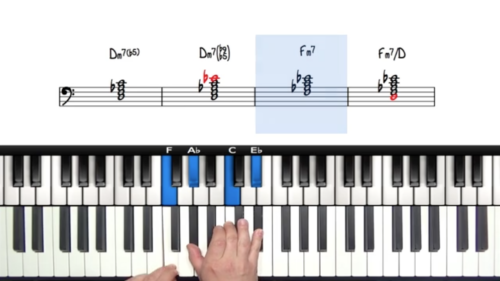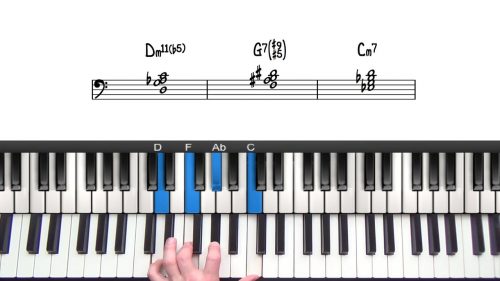“You Must Believe In Spring” Tutorial
In this lesson we’re going to create a solo piano arrangement of the beautiful ballad ‘You Must Believe In Spring’, written by Michel Legrand. The song originally appeared in a French movie ‘Rocheforts Girls’.
We’re going to be playing the tune in the key of B minor, modulating to C minor.
Notable Versions To Listen To
Good versions to check out are Bill Evans versions with his trio, and also the duo with Tony Bennett. When learning a new song, you should listen to as many vocal versions as possible. It’s a good exercise to sing and learn the melody, and also you will get familiar with the lyrics and the meaning behind the lyrics.
Practice Tips
-
This song is an excellent minor tune to take through all the keys because of the modulations and the interesting harmonic movement.
-
Check out the original version from the movie as well as the versions of the actual composer Michel Legrand.
-
Michel Legrand is known for his challenging harmonies, and this tune has some unusual chord changes for the jazz standard repertoire. So be prepared!







Hello Tuomo: this is truly a fantastic little tune with such unexpected and ever-so-LeGrand harmonies that I decided I have to really ‘get it’, both for the theory as well as ….well, everything else. I listened to many renditions and it seems impossible to make this tune sound bad, it carries itself. [LeGrand and Phil Woods in Montreal, 01, really let loose with this one!!!].
Thank you for making it so clear and for your transcription that even I can play (with some attention, so far). Best, Smole
Smole thank you so much, I’m so glad to hear you liked the arrangement, stay tuned for more! All the best, -T
Hello Tuomo: just came back from a 3-month trip to Europe during which I did not touch a keyboard. Came back and was pleasantly surprised how much ‘muscle memory’ re: this tune I found in my fingers in ‘playing’ it. A question: I could get an intro from the last few bars. If I recall another lesson (yours?) on intros, when the tune starts with a minor II chord, it is desirable for the intro to end on VI chord. Did I understand that correctly? If so, any suggestions on the intro chords that would end on Ab7 or something like that? Thanks greatly. Smole
Hi Smole, thank you for writing!
You are correct, a good way to end an intro is to have the last chord be a dominant to the first chord of the song ( for example VI7 –> II minor)
So, if the tune starts on Ab7, I would most likely end the intro with Eb7.
Considering the other chords in the intro I would want to know what tune we are talking about, as the song could have an influence to the intro.
Basically, I could use a turnaround (Ab – F7 – Bb-7 . Eb7), or chain of dominants (C7 – F7 – Bb7 – Eb7 –> Ab7),
or any variation of those (for example C-7 instead of Ab in the turnaround, or tritone subs in the dominant chain (C7 – B7 – Bb7 – Eb7)
Let me know what tune you’re working on so I can help better!
All the best,
-Tuomo
Thank you, Tuomo, for the quick and thorough response. I am sorry I was not clear: I was referring to the You Must Believe in Spring. Since the first chord in the tune is C#m7 I guess I should end the intro with G#7and then go to C#m7? However, I have to study your generic suggestions more fully to understand the theory. Of course, any suggestions specific to the You Must Believe will be most welcome since I would like to have a whole arrangement with the intro. Again, thanks, Smole
Hi Smole,
I put together a suggestive intro for you that you can use and/or modify.
This one only repeats the last few bars of the tune, then bass descending from C- to Bb and finally to Ab7 that you mentioned earlier. Hope this helps!
All the best,
-Tuomo
FANTASTIC, Tuomo, I am ever so grateful. This is, of course, not only for the You Must Believe in Spring but a prototype for other, similar tunes. I hope other benefits from this example. Thank you. Smole
No problem, let me know if I can help with anything else!
-Tuomo
Hello Tuomo, after struggling, without success, to understand this I am asking: why do you call Absus chord (in the last bar of the intro) a sus chord? There is no D in it. I just revisited the whole lesson on sus chords that Hayden did and still do not understand the Absus item. Help, pls? I truly like to understand theory behind everything so that I can apply it to other, similar situations. Thanks much, Smole
Hi Smole, sorry for late repsonse!
Absus chord doesn’t have a D in it in any case, are you sure you don’t mean Db? Sus means it is a dominant chord that instead of the major third has 4th, here example:
You can always use sus chords instead of any dominant.
You can also think of the sus chord as the 2 chord (minor 7) that has the 5 in the bass, for example:
So, the voicing I used in the intro is just a Eb-add9 chord with Ab in the bass, still functions as a sus chord even without the Db
Let me know if this helps, o if you have any further questions!
-Tuomo
Thanks, Tuomo, truly. I’ll study your response so that I fully understand it. Of course you were right about Db instead of D in the Absus chord, sorry. Thanks again, Smole
Thank you Smole, let me know if you have any questions!
-T
This is great. Likewise appreciate this into Tuomo!
Agree – this song has definitely captured my desire to learn to play it. A lovely transcription Tuomo!!! I’ve listened to many renditions sung by vocalists and inspiring!
I’d love to see if you could look at transcribing Oscar Peterson’s “When Summer Comes”… equally lovely tune… I’d love to learn how to play that as well.
Beautiful song and arrangement. This one gets to me. Thank you Tuomo for sharing this song.